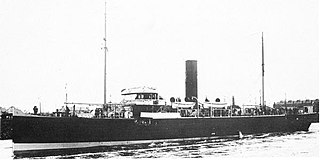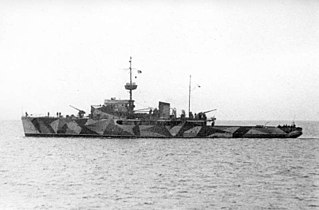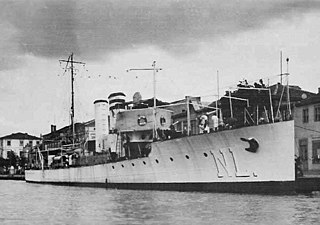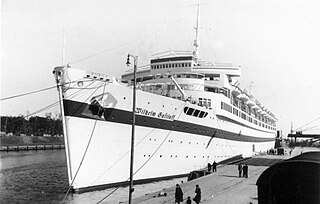
Q-ships, also known as Q-boats, decoy vessels, special service ships, or mystery ships, were heavily armed merchant ships with concealed weaponry, designed to lure submarines into making surface attacks. This gave Q-ships the chance to open fire and sink them.

The M-class submarines, also Malyutka class, were a class of small, single-, or 1½-hulled coastal submarines built in the Soviet Union and used during World War II. The submarines were built in sections so they could easily be transported by rail. The production was centered in the Gorky Shipyard on the Volga River, after which the sections were transported by railway to Leningrad for assembly and fitting out. This was the first use of welding on Soviet submarines.

The Shchuka-class submarines, also referred to as Sh or Shch-class submarines, were a medium-sized class of Soviet submarines, built in large numbers and used during World War II. "Shchuka" is Russian for pike. Of this class, only two submarines entered service after 1945, although they were launched before the war.
The Black Sea Campaigns were the operations of the Axis and Soviet naval forces in the Black Sea and its coastal regions during World War II between 1941 and 1944, including in support of the land forces.

NMS Delfinul was a Romanian submarine that served in the Black Sea during the Second World War. It was the first submarine of the Romanian Navy, built in Italy under Romanian supervision.

HMS Douglas was an Admiralty type flotilla leader of the British Royal Navy. Built by Cammell Laird, Douglas commissioned in 1918, just before the end of the First World War. During the Second World War, Douglas served with Force H out of Gibraltar and as a convoy escort. She was sold for scrap in March 1945.

NMS Amiral Murgescu was a minelayer and convoy escort of the Romanian Navy, the first sea-going warship built in Romania and the largest Romanian-built warship of World War II. She laid numerous minefields, from the Bulgarian port of Burgas to the Crimean port of Sevastopol, which inflicted significant losses to the Soviet Black Sea Fleet. She also carried out numerous convoy escort missions and took part in the Axis evacuation of the Crimea in May 1944. Due to her success in combat, she was decorated twice by May 1944. She was captured by the Soviet Union in September 1944 and served until 1988, when she was scrapped.

Submarine warfare in the Black Sea in World War II during 1941 primarily involved engagements between submarines of the Soviet Black Sea Fleet attacking Axis merchantmen defended by Romanian and Bulgarian warships. These engagements were a part of the naval Black Sea campaigns between Axis and Soviet naval forces.

The Battle of Jibrieni was an attack on 17 December 1941 by a Soviet submarine on an Axis convoy and its Romanian escorts off the coast of the Romanian village of Jibrieni. The engagement ended with the sinking of the attacking Soviet submarine M-59.
The Romanian Navy during World War II was the main Axis naval force in the Black Sea campaigns and fought against the Soviet Union's Black Sea Fleet from 1941 to 1944. Operations consisted mainly of mine warfare, but there were also escort missions and localized naval engagements. The largest naval action fought by the Romanian Navy was the 26 June 1941 Raid on Constanța, and its most extensive operation was the 1944 evacuation of the Crimea.
The action of 6 December 1941 was a confrontation between the Bulgarian and Soviet navies in the Black Sea during World War II, taking place near the Bulgarian coast at Cape Emine.

The action of 9 July 1941 was a naval engagement between the Soviet and Romanian navies during World War II, taking place near the Romanian port-city of Mangalia.

NMS Sublocotenent Ghiculescu was a specialized ASW gunboat of the Romanian Navy. Initially built as a French warship in late World War I, she was purchased by Romania in 1920 and fought during World War II, sinking two submarines and one motor torpedo boat. After 1 year of Soviet service, she was returned to Romania and served as a survey vessel until 2002.

The Soviet Navy launched the Soviet submarine Baltic Sea campaign in 1942 to harass the strategic iron-ore traffic from neutral Sweden to Nazi Germany during World War II. The Soviet Union and the German Reich fought each other on the Eastern Front (1941-1945) during the war. The Allies also launched other operations - especially involving the Royal Navy - against the traffic.
Submarine warfare in the Black Sea in World War II during 1942 involved engagements between primarily submarines of the Soviet Black Sea Fleet attacking Axis merchantmen defended by Romanian and German naval warships. These engagements were a part of the Black Sea campaigns between Axis and Soviet naval forces.

Submarine warfare in the Black Sea in World War II during 1944 involved engagements between submarines of the Soviet Black Sea Fleet attacking Axis merchantmen, defended by Romanian and German naval warships, as well as German U-boats and Romanian submarines attacking Soviet merchants on the eastern Black Sea. Before the conclusion of the campaign, Romania joined the Allies after King Michael's Coup. These engagements were a part of the naval Black Sea campaigns.

The Soviet submarine Baltic Sea campaign in 1941 was launched by the Soviet Navy at the early stage of Operation Barbarossa. The offensive was hampered by the quick German ground advance and the retreat of Soviet naval vessels from the main Baltic harbors.

The Soviet naval Baltic Sea campaign in 1945 was launched by the Soviet Navy to harass enemy shipping and naval military assets of Nazi Germany on the Eastern Front during World War II. Both submarines and surface units of the Soviet Navy were employed. The campaign scored successes during Operation Hannibal.

Between 1941 and 1944, Romania held control over much of the Ukrainian Black Sea coast East of the Crimea. This was acquired during Operation Barbarossa. The Romanian conquest of the Soviet Western Black Sea coast started in July 1941 during Operation München and ended in October that year, after the Siege of Odessa. In the aftermath of these actions, Romania (re)acquired two new sectors of coastline: the Bessarabian coast and the Transnistrian Coast. The latter was lost in April 1944, but the former was successfully defended until August 1944.
I-72, later I-172, was a Kaidai-class cruiser submarine of the KD6 sub-class built for the Imperial Japanese Navy (IJN) during the 1930s. She served in the early months of World War II, supporting the attack on Pearl Harbor, patrolling in Hawaiian waters in early 1942, and taking part in the Guadalcanal campaign before she was sunk in November 1942.















